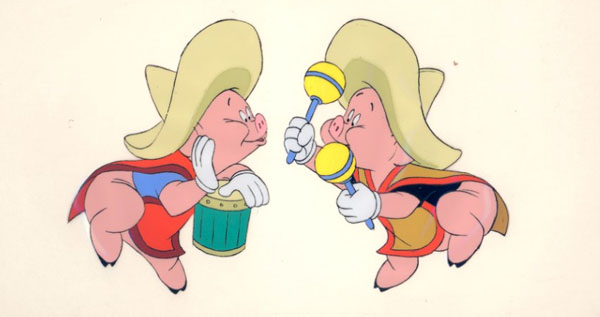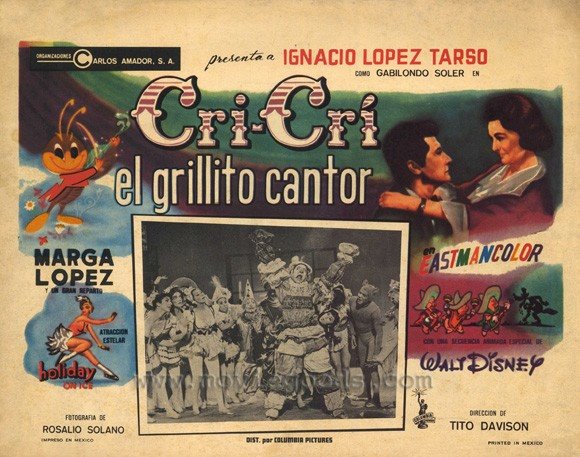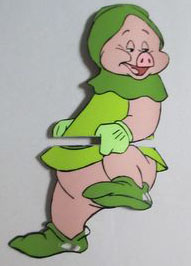
In 2013, Jerry Beck posted about a Mexican sequel to Disney’s Three Little Pigs. This article elaborates on the story behind this odd bit of Disney obscura.
Today, it is hard to imagine the impact of the Disney Silly Symphony, Three Little Pigs. It not only won the 1934 Academy Award for best animated film (the year after Flowers and Trees won the very first Oscar given to a cartoon) but it was the most successful cartoon that had ever been released up to that time.
 It was the 36th Silly Symphony (the seventh in Technicolor) and cost $22,000 (not counting prints and publicity) but earned over $150,000 in its first 15 months of release. The average Silly Symphony generally grossed around $50,000 in its first year of release at this time.
It was the 36th Silly Symphony (the seventh in Technicolor) and cost $22,000 (not counting prints and publicity) but earned over $150,000 in its first 15 months of release. The average Silly Symphony generally grossed around $50,000 in its first year of release at this time.
The Three Little Pigs premiered at Radio City Music Hall on May 25, 1933 and ran for one week. However, it did very well at local neighborhood theaters as well as runs at other New York theaters, including the Roxy and the Translux.
There were requests from theaters for more cartoons featuring the pigs, and these requests were supported by Roy Disney who convinced Walt it would be good for the business and bring in much needed income.
Walt later regretted bowing to pressure and producing three more cartoons featuring the characters: The Big Bad Wolf (1934) Three Little Wolves (1936) and The Practical Pig (1939). These were not bad cartoons, but they were not as memorable as the original, and it prompted Walt to offer his famous statement: “You can’t top pigs with pigs.” It meant that instead of sequels and repeats, that the Disney Studio would devote itself to always finding something new.
The Disney pigs did pop up in cameos in other Disney cartoons, including Mickey’s Polo Team, Toby Tortoise Returns, Mickey’s Christmas Carol and Who Framed Roger Rabbit.
In the Fall of 1962, Walt Disney called Bill Justice and X. Atencio to his office to introduce them to Carlos Amador and his movie star wife, Marga. Disney fans may know Justice as the primary animator of Chip’n’Dale in their classic cartoons, and Atencio as the lyricist for both the Pirates of the Caribbean and Haunted Mansion theme park attractions. However, their many different projects for the Disney Company could literally fill books.
Amador was preparing a live action movie about the life of a famous south-of-the-border writer. Since one of the stories was about the three little pigs, Amador wanted to use Disney’s three little pigs in a four-minute animated segment.
The reason Walt agreed and assigned Justice and Atencio to the project was that half of the profits would go to help provide poor Mexican children a free lunch each school day. Walt had decided to donate the animation, especially since the charity was the favorite of the Republic of Mexico’s first lady and it was, in fact, the only way many children could be persuaded to attend school.
Amador wrote the adaptation with Justice and Atencio doing the production work.

In the film, a live action young boy and girl on their bed look at a framed picture of three sleeping pigs. As they gaze at the picture, it comes to cartoon life. The three little pigs are tucked into bed and given a kiss by their mother.
 One dreams of being a king and having lots of tasty treats brought for him to gorge on. Another pig dreams of having his own rowboat but with disastrous results when he ends up in the water and back in bed, a tear trickles down his face.
One dreams of being a king and having lots of tasty treats brought for him to gorge on. Another pig dreams of having his own rowboat but with disastrous results when he ends up in the water and back in bed, a tear trickles down his face.
The Practical Pig dreams of the Big Bad Wolf threatening his mother that she must pay the rent by tomorrow. La Fiesta Las Flores (that features re-used animation from the 1944 The Three Caballeros) offers the pigs an opportunity to win some money to pay the rent as the three pigs perform a musical number.
 Of course, they win and return home late at night whistling Who’s Afraid of the Big Bad Wolf. However, they are attacked by the wolf, but escape as the wolf shakes his fist. The wolf is standing under a palm tree and a coconut drops from its palms to bonk him on the head. The pigs give the money to their mother, who hugs all three of them at one time. The film then shifts back to the live action children.
Of course, they win and return home late at night whistling Who’s Afraid of the Big Bad Wolf. However, they are attacked by the wolf, but escape as the wolf shakes his fist. The wolf is standing under a palm tree and a coconut drops from its palms to bonk him on the head. The pigs give the money to their mother, who hugs all three of them at one time. The film then shifts back to the live action children.
A few months later the finished product was shown to Walt for his approval, and it was followed by an invitation from Amador for Justice and Atencio, along with Gene Armstrong of the Disney Studio’s Foreign Department, and their wives to visit for ten days. The Disney staff was treated like royalty. At the Mexico City airport, they were greeted by a mariachi band and their wives were given bouquets of roses.
One evening at a special dinner as the guests of honor of the First Lady of Mexico, Justice and Atencio were given gold medals for their work.
A Disney press release from Fall of 1963 announced:
“The Three Sleepy Pigs, a new four minute segment of animation in Spanish, has been produced by Walt for incorporation in a live action Mexican feature called “Cri-Cri, El Grillito Cantor” or in English, “Cri-Cri, the Little Singing Cricket”.
“The feature itself is based on the life of Gabilondo Solar, a famous south of the border song writer, while Walt’s contribution to it is based on Solar’s popular ballad, Los Cochinitos Dormilones.
“Proceeds of the feature, which is set for widespread theatrical release throughout Mexico beginning in October, will go to the Institute for the Protection of Mexican Children, an organization that maintains thirty-two plants engaged in the packaging and shipping of food to million school-age youngsters all over the country.”
Justice and Atencio were invited back to Mexico again in November 1963 to attend an international film festival, where the completed film was to be given an award. Tragically, the screening was during the same time that President Kennedy was assassinated. Justice and Atencio attended and the film festival continued, but Bill told me he still remembers how deeply the people at the festival expressed their sympathy when they discovered he was a citizen of the United States.
Although they have been eclipsed by other Disney animated stars, at one time the Three Little Pigs were superstars whose huge success allowed the Disney Studio to flourish and create even greater triumphs.


 Jim Korkis is an internationally respected animation historian who in recent years has devoted his attention to the many worlds of Disney. He was a columnist for a variety of animation magazines. With his former writing partner, John Cawley, he authored several animation related books including The Encyclopedia of Cartoon Superstars, How to Create Animation, Cartoon Confidential and Get Animated’s Animation Art Buyer’s Guide. He taught animation classes at the Disney Institute in Florida as well as instructing classes on acting and animation history for Disney Feature Animation: Florida.
Jim Korkis is an internationally respected animation historian who in recent years has devoted his attention to the many worlds of Disney. He was a columnist for a variety of animation magazines. With his former writing partner, John Cawley, he authored several animation related books including The Encyclopedia of Cartoon Superstars, How to Create Animation, Cartoon Confidential and Get Animated’s Animation Art Buyer’s Guide. He taught animation classes at the Disney Institute in Florida as well as instructing classes on acting and animation history for Disney Feature Animation: Florida.




















































Is the feature available on DVD somewhere?
Cri Cri El Grillo Cantador (Cri Cri the Singing Cricket) is one of my all time favorite family movies from Mexico along with Katy the Catepillar and Katy,Kiki and Kiko. The Three Sleepy Pigs sequence involved a letter that Gabilondo Solar from a young listener who younger brother was recovering from a illness and refuses to take his medicine. Gabiondo (who’s radio show was broadcast live on XEW Radio) told the youngster that his little buddy Cri Cri was sad that he wasn’t taking his meds and if he was a good boy and take his meds that he’ll reward him by telling him and the rest of the listening audience a story about how The Three Little Pigs help their “Mami” save the family home from The Big Bad Wolf (who was their landlord) by entering a talent show singing a bright Spanish version of Who’s Afraid of the Big Bad Wolf.
Note in the background of the children’s bedroom there were several wall plaques with several Disney characters including Goofy (in his Goofy Geef personage).
Gabiondo Solar was one of the most iconic songwriters in Mexican history and his songs such as La Patita, Raton Vaquero,Marcha de las Letras,Rey Bombón I,Di Porque,Cancion de las Brujas and others are still enjoyed to many generations of listeners throughout Latin America.
I should know because I grew up listening to the wonderful songs of Cri Cri 😉
The little things I wouldn’t know simply for being an Ohioan!
Interesting to see the pigs and the wolf animated in the Xerox style which became the norm for Disney animation from the late 50’s to the late 80’s. It gives them a looser, more “modern” look than in their classic short. It’s also interesting to see the pigs’ mother. (A picture on the wall in the 1933 short shows the fate of their father.)
I read the original post, but it’s been a while and I had forgotten this little bit of Disney trivia. Fascinating! Thanks for sharing it afresh!
I guess Porky wasn’t the only pig with a kid/adult identity crisis.
I have some cels from this, and the background. or a copy, from the scene in the throne room. I thank you for informing of what it was from.
Reminded an eBay auction came up where a cel of the Big Bad Wolf was somehow stuck in with a coyote from the episode of the Disney anthology show “The Coyote’s Lament”, it sorta made me laugh giving the size differences of both characters.
https://www.pinterest.com/pin/30891947417674709/
I have a cel of 2 pigs dancing in sombreros from this cartoon. Do have an idea of how much it would be worth? Thanks!
I remember Comcast use to have a bunch of Mexican feature films from the 1940s – 1960s available for viewing OnDemand and this one popped up one month. Unfortunately none of the films were subtitled and all a non-spanish speaking person such as myself could do was flip through them and admire the old studio logos and production values of the movies. It’s ashame as this movie along with Productions Pereda’s musical melodramas with Maria Antonietta Pons looked like a lot of fun!
That’s always going to be a thing when it comes to having an interest in foreign things. It’s always a language barrier unless you took the time to learn that language (I had three years of Spanish in high school but can barely get by with it these days).
I think Dish Network and DirecTV have big Latino packages that include channels such as Cine Nostalgia, De Pelicula, De Pelicula Clasico, CIne Mexicano, and Cine Estelar, all which specialize in Mexican films from the 1930’s up to the early 2000’s. I don’t think these are subtitled at all, either.
Some wonderful bits of high-energy animation, and a fascinating anecdote. Thanks Jim for those details I never knew.
The “high-energy animation” of the dancing pigs would be more impressive if it wasn’t all traced from The Three Caballeros. 😉
This is an interesting post, and thanks for sharing this bit of rare Disney animation. If I ever get another crack at “THE THREE CABALLEROS” and “SALUDOS AMIGOS” in one collection, this should be added, along with its story, as a special feature. C’mon, boys. This is not only classic stuff from Uncle Walt, himself, it is worth exposing to new generations.